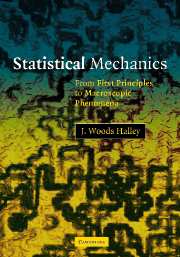Book contents
- Frontmatter
- Contents
- Preface
- Introduction
- Part I Foundations of equilibrium statistical mechanics
- 1 The classical distribution function
- 2 Quantum mechanical density matrix
- 3 Thermodynamics
- 4 Semiclassical limit
- Part II States of matter in equilibrium statistical physics
- Part III Dynamics
- Appendix: Solutions to selected problems
- Index
1 - The classical distribution function
Published online by Cambridge University Press: 05 June 2012
- Frontmatter
- Contents
- Preface
- Introduction
- Part I Foundations of equilibrium statistical mechanics
- 1 The classical distribution function
- 2 Quantum mechanical density matrix
- 3 Thermodynamics
- 4 Semiclassical limit
- Part II States of matter in equilibrium statistical physics
- Part III Dynamics
- Appendix: Solutions to selected problems
- Index
Summary
Historically, the first and most successful case in which statistical mechanics has made the connection between microscopic and macroscopic description is that in which the system can be said to be in equilibrium. We define this carefully later but, to proceed, may think of the equilibrium state as the one in which the values of the macroscopic variables do not drift in time. The macroscopic variables may have an obvious relation to the underlying microscopic description (as for example in the case of the volume of the system) or a more subtle relationship (as for temperature and entropy). The macroscopic variables of a system in equilibrium are found experimentally (and in simulations) to obey historically empirical laws of thermodynamics and equations of state which relate them to one another. For systems at or near equilibrium, statistical mechanics provides the means of relating these relationships to the underlying microscopic physical description.
We begin by discussing the details of this relation between the microscopic and macroscopic physical description in the case in which the system may be described classically. Later we run over the same ground in the quantum mechanical case. Finally we discuss how thermodynamics emerges from the description and how the classical description emerges from the quantum mechanical one in the appropriate limit.
- Type
- Chapter
- Information
- Statistical MechanicsFrom First Principles to Macroscopic Phenomena, pp. 7 - 26Publisher: Cambridge University PressPrint publication year: 2006



